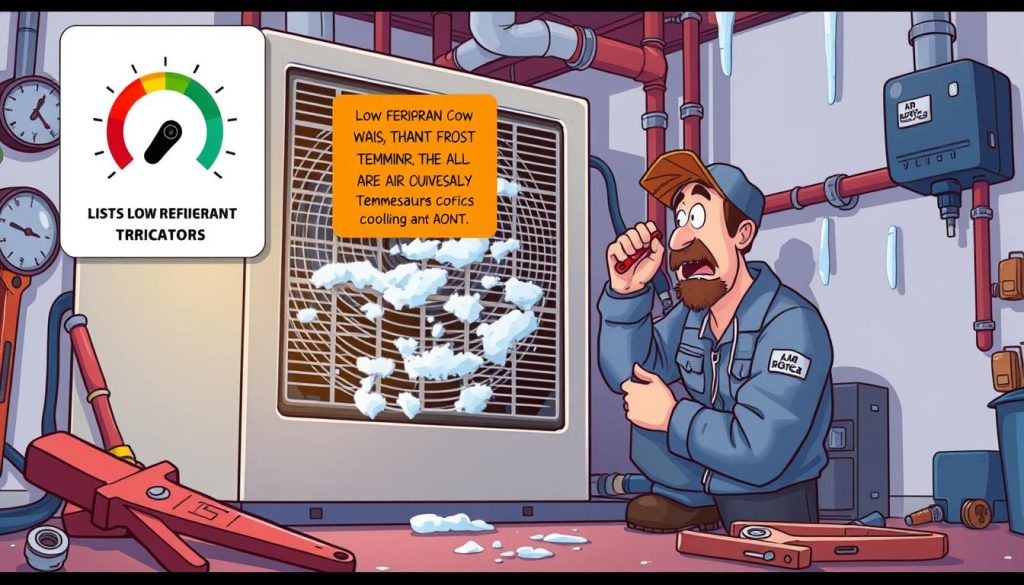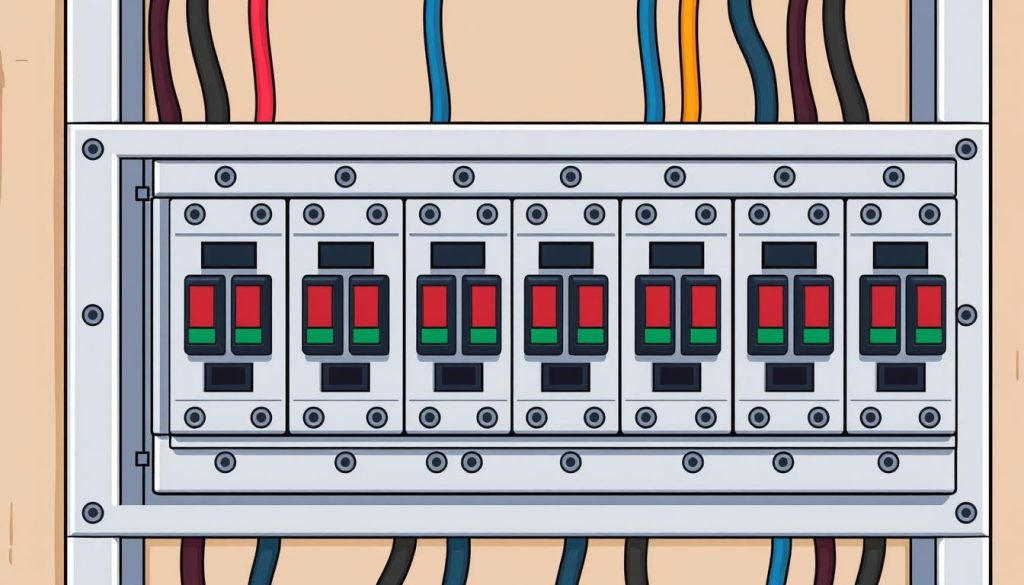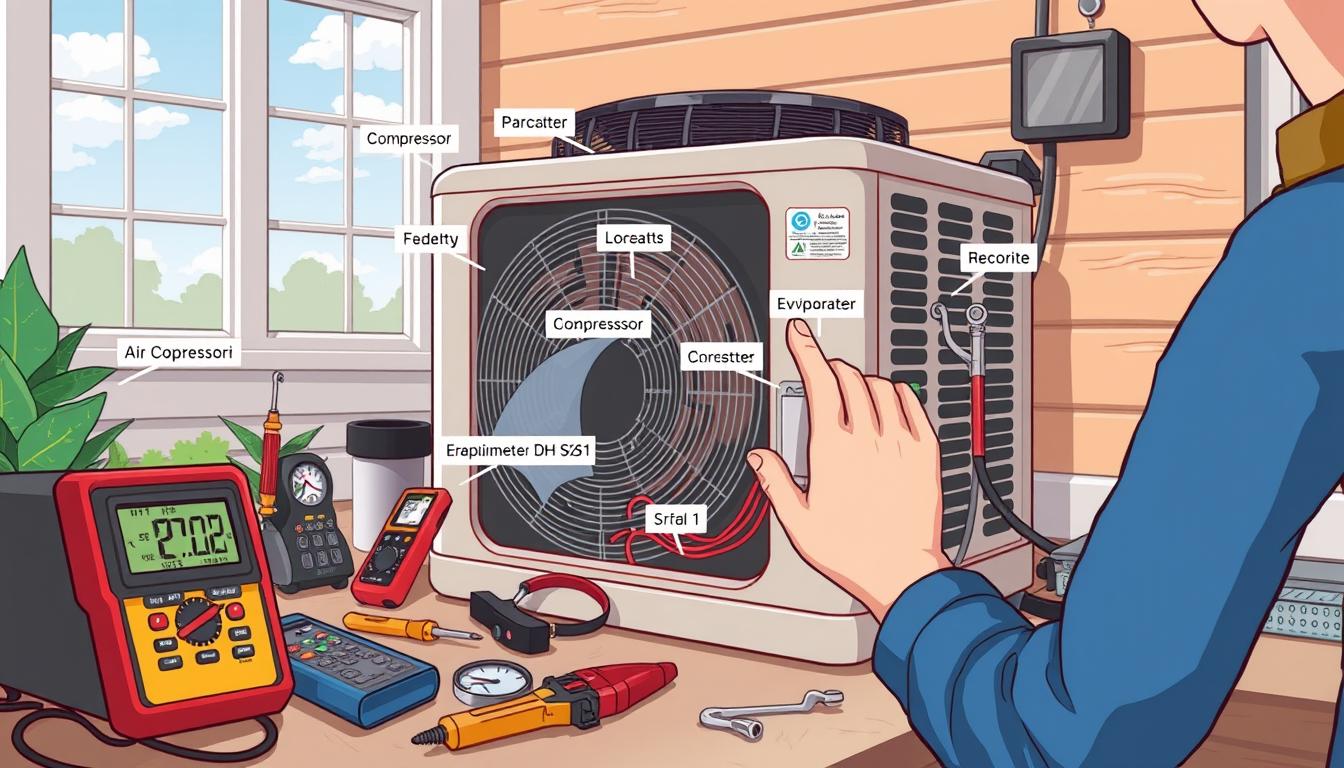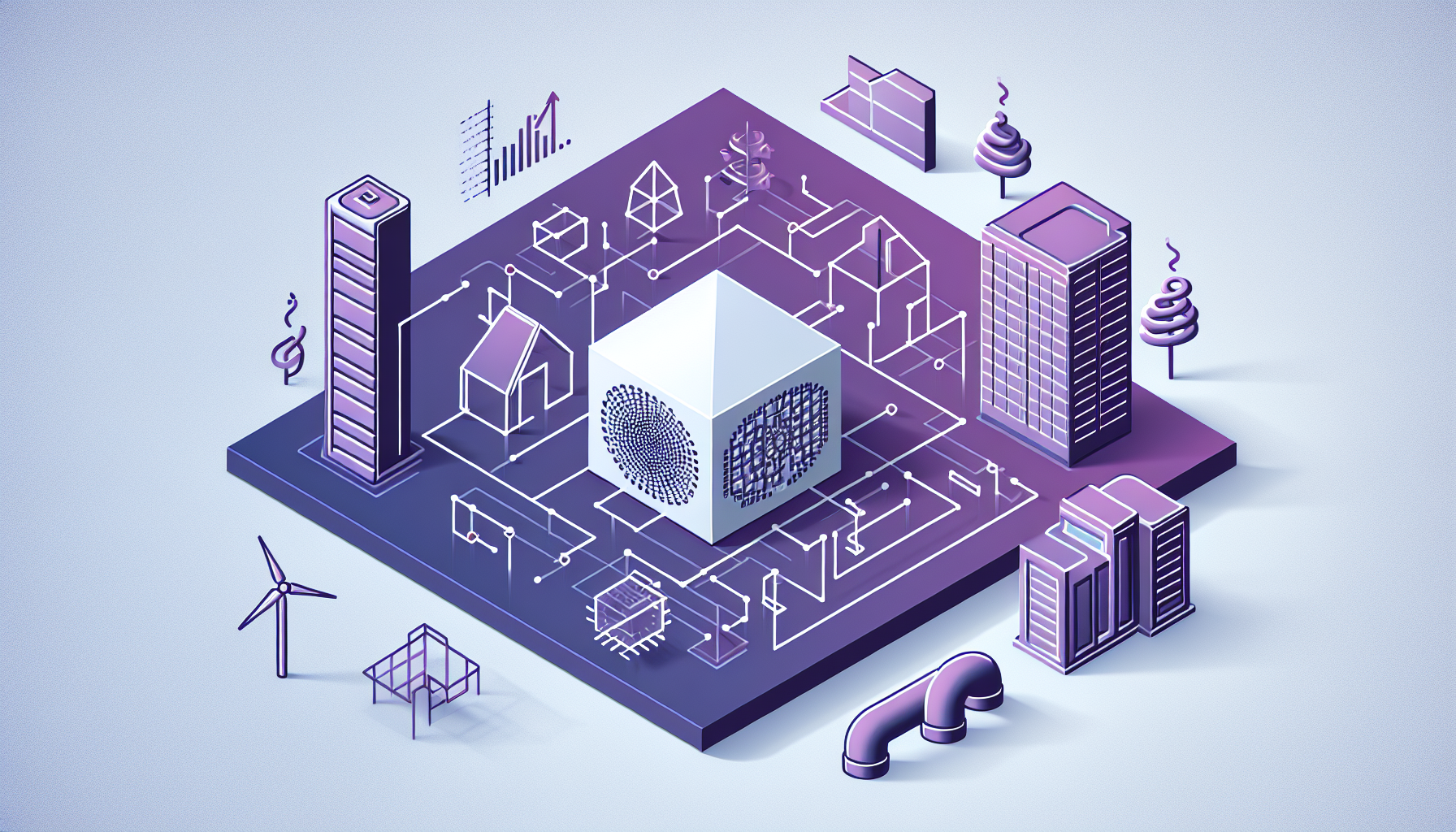If your AC isn’t cooling your home, it’s really annoying. Luckily, many AC problems are easy to find and fix on your own. This guide will help you figure out what’s wrong with your AC.
We’ll show you how to check your thermostat and the condenser unit. These are key places to look when your AC isn’t working right. By doing some simple checks, you might be able to fix your AC without needing a professional.
Key Takeaways
- Many AC issues can be diagnosed and fixed without professional help
- Start by checking your thermostat settings and air filters
- Inspect the condenser unit and look for signs of refrigerant leaks or a frozen evaporator coil
- Ensure your home’s electrical components and circuit breakers are functioning correctly
- Schedule regular professional maintenance to prevent future AC problems
Check Your Thermostat Settings
When you’re having trouble with your air conditioning, start by checking your thermostat settings. Many AC problems come from thermostat issues. It’s key to make sure your thermostat is working right. Let’s look at some common thermostat problems and how to fix them to get your HVAC system working better.
Common Thermostat Issues
One big problem is setting the thermostat too high. If it’s set too high, your AC won’t turn on. This makes your home too warm. Also, if you accidentally switch it to “heat” instead of “cool,” your AC won’t work.
Another issue is with a programmable thermostat’s schedule. If the schedule doesn’t match your needs, your HVAC thermostat might not turn on when you want it to.
How to Adjust Thermostat Settings
- Make sure the thermostat is in “cool” mode.
- Set the temperature to what you want it to be.
- Change the fan setting to “auto” to avoid constant blowing.
- Check the programming on a programmable thermostat to see if it fits your schedule.
By making these simple changes to your air conditioner settings, you can often fix common problems. Keeping an eye on your thermostat helps your cooling system work better and more efficiently.
Inspect and Change Air Filters
A dirty or clogged air filter can really hurt your AC system’s performance. A dirty AC air filter limits airflow, making your HVAC air filter maintenance system work harder. It’s important to know the dirty air filter symptoms and how to air conditioner air filter replacement properly.
Signs of a Dirty Air Filter
Here are some signs your AC air filter needs cleaning:
- Warm air blowing from the vents
- Weak or reduced airflow from the registers
- Your AC frequently turning on and off (short-cycling)
- A noticeable increase in your energy bills
Steps to Clean or Replace Air Filters
First, find and check your air filter. It’s usually in the furnace or between the cabinet and return duct. Follow your manufacturer’s advice on cleaning or replacing it – usually every 1 to 3 months.
To clean, vacuum or rinse the filter, then put it back. For a new one, just swap out the old filter with a new one.
Keeping your AC air filters clean is key to a well-working AC system. By fixing dirty air filter symptoms and regularly air conditioner air filter replacement, your HVAC will cool your home reliably all season.
How do I diagnose what’s wrong with my AC?
Figuring out what’s wrong with your AC can seem tough, but it’s doable. By checking each part, you can find the main problem and fix it. This guide will help you with AC troubleshooting, air conditioning diagnostics, and HVAC repair diagnosis to spot AC issues.
Start by checking the thermostat. Make sure it’s set to “cool” and the temperature is lower than the room’s. If the thermostat isn’t working right, your AC won’t turn on or keep the right temperature.
Then, look at and change the air filters. Dirty filters block air flow, making your AC work harder and less well. Check for dirt or dust and swap out the filter when needed.
| Symptom | Possible Cause | Solution |
|---|---|---|
| AC not turning on | Tripped circuit breaker | Reset the circuit breaker |
| Warm air blowing | Low refrigerant levels | Refill refrigerant |
| Frozen evaporator coil | Blocked airflow | Clean or replace air filters |
By doing these steps and fixing any problems, you can fix common AC troubleshooting issues. If it still doesn’t work, it’s time to get a pro HVAC technician to check and fix it.
Check for Low Refrigerant Levels
If your air conditioning system isn’t cooling enough, it might be because of low refrigerant levels. Refrigerant is key for cooling your home. It absorbs heat from inside and moves it outside. Without enough, your AC can’t cool your home properly.
This can cause your home to stay warm, your AC to run all the time, and it might turn on and off too fast (short cycling).
Symptoms of Low Refrigerant
Here are some common signs that your AC may have low refrigerant levels:
- Insufficient cooling – Your home doesn’t cool down as it should, even when the AC is on full blast.
- Constant running – The air conditioner keeps running without stopping, unable to cool your home to the right temperature.
- Short cycling – The AC turns on and off quickly, never finishing a full cooling cycle.
If you see any of these AC refrigerant issues, don’t try to add more refrigerant yourself. It needs special tools and training. Instead, call an HVAC expert. They can find any HVAC refrigerant leak and fix it to get your AC cooling again.

Troubleshoot a Frozen Evaporator Coil
Homeowners often face the problem of a frozen AC evaporator coil. This part, inside the air handler unit, pulls heat from indoor air. A frozen coil can make your HVAC system cool less effectively.
Signs that your evaporator coil is icing up include:
- Little to no cooling from your AC
- Abnormally high utility bills
- Excessive condensate drainage
- Visible frost or ice buildup on the refrigerant lines or outdoor unit
Frozen AC coils often stem from dirty air filters, low refrigerant levels, or blower fan problems. Trying to thaw it yourself can damage it more. So, call an HVAC technician if you think your HVAC evaporator coil problem.
| Potential Cause | Symptoms | Solution |
|---|---|---|
| Dirty air filter | Restricted airflow can cause the coil to freeze | Replace or clean the air filter |
| Low refrigerant levels | Lack of refrigerant allows the coil to get too cold and freeze | Have an HVAC technician check and recharge the refrigerant |
| Blower fan issues | A malfunctioning blower fan reduces airflow over the coil | Have an HVAC technician inspect and repair the blower fan |
Watch for signs of a frozen evaporator coil and fix the cause quickly. This way, you can avoid this common AC issue and keep your home cool and comfy all summer.
Diagnose Issues with the Condensing Unit
The outdoor condensing unit is key to your air conditioning system. It houses the compressor, condenser coil, and fan. If it’s not working right, you’ll face cooling problems. Knowing common issues can help you fix your AC system.
Common Condensing Unit Problems
One big problem is when the unit won’t turn on. This could be because of a tripped circuit breaker, a bad run capacitor, or a compressor that’s not working. Another issue is short cycling, where it turns on and off fast. This might mean there’s a problem with the refrigerant or the compressor.
Also, the unit might not cool well. This could be because the condenser coil is dirty, there’s a refrigerant leak, or the fan motor is faulty. These problems can make your home too hot, making it uncomfortable.
Fixing the condensing unit needs special skills and tools. It’s best to get an HVAC technician to check and fix it. Ignoring problems with the condensing unit can lead to bigger issues with your HVAC system. It might even stop your AC from working altogether.
| Common Condensing Unit Problems | Potential Causes |
|---|---|
| Unit not turning on | Tripped circuit breaker, faulty run capacitor, malfunctioning compressor |
| Short cycling | Refrigerant leaks, compressor issues |
| Inadequate cooling | Dirty condenser coil, refrigerant leak, fan motor problems |
Inspect Air Vents and Ductwork
Your home’s air vents and HVAC ductwork are key to your AC system’s work. If air vents are blocked or closed, your AC has to work harder. This can cause uneven cooling, frozen coils, and even damage to the compressor.
Signs of Blocked or Closed Vents
Some common signs include:
- Warm spots in your home
- Water leaks around the vents or in the ductwork
- The AC short-cycling (turning on and off frequently)
Make sure all your home’s supply and return air vents are open. Check them for any furniture, rugs, or other objects blocking them. Also, look for any damage, leaks, or blockages in the ductwork that could be affecting airflow.
Keeping your air distribution system clear and efficient is crucial. It helps your AC work better and prevents blocked AC vents, closed air registers, HVAC ductwork problems, and other air distribution issues.
| Common HVAC Ductwork Issues | Potential Causes | Impact on AC Performance |
|---|---|---|
| Leaks in ductwork | Damaged or poorly sealed joints, holes, or cracks | Reduced airflow, uneven cooling, energy inefficiency |
| Blocked or obstructed vents | Furniture, rugs, or other objects blocking air vents | Restricted airflow, frozen coils, compressor damage |
| Poorly designed or installed ductwork | Improper sizing, sharp turns, or inadequate insulation | Uneven airflow, hot and cold spots, energy waste |
Regularly checking your home’s air vents and ductwork helps. It lets you find and fix problems that might be affecting your AC’s performance and efficiency.
Check Circuit Breakers and Electrical Components
If your air conditioner won’t turn on, it might be an electrical system issue. First, check the circuit breakers in your home’s electrical panel. If the breaker for the AC unit has tripped, just reset it. But, if it trips again when you turn the AC on, you have a bigger electrical problem. You’ll need a licensed electrician to fix it.
HVAC professionals can find any wiring faults, failing parts, or other electrical issues stopping your AC from working. Trying to fix the electrical system yourself is risky. It’s safer to let the experts handle it.
Common AC Circuit Breaker Issues
- Tripped or faulty circuit breaker
- Loose wiring connections
- Overloaded electrical circuit
- Damaged or worn-out electrical components
Steps to Diagnose Electrical Problems
- Check the circuit breaker for the AC unit
- Inspect all wiring and connections for damage or loose fittings
- Test the electrical components like the capacitor, relay, or contactor
- Measure the voltage and amperage to ensure proper electrical supply
- Call a licensed electrician if you suspect a larger electrical issue
| Symptom | Possible Cause | Solution |
|---|---|---|
| AC circuit breaker trips | Overloaded circuit, faulty wiring, or failed electrical component | Reset breaker, inspect electrical system, and replace any failed parts |
| AC won’t turn on at all | Tripped circuit breaker or issue with power supply | Check circuit breaker and electrical connections, call electrician if needed |
| Frequent AC circuit breaker trips | Ongoing electrical problem or system overload | Diagnose and resolve root electrical issue by consulting a professional |

Schedule Professional AC Maintenance
While you can fix many HVAC maintenance plan issues yourself, some need a pro. Regular AC tune-up and professional AC inspection keep your AC running well. This also stops future problems.
An HVAC maintenance plan includes a full check, clean, and tune-up. It makes your equipment last longer, saves energy, and finds small issues early. Join an preventative HVAC service plan for yearly care. This saves you money and stress.
Benefits of Scheduled AC Maintenance
- Extends the lifespan of your HVAC equipment
- Improves energy efficiency and lowers utility bills
- Identifies and addresses minor issues before they become major problems
- Provides peace of mind and helps avoid unexpected breakdowns
- Maintains optimal performance and airflow throughout your home
What to Expect During a Professional AC Tune-Up
- Comprehensive system inspection
- Cleaning of coils, fans, and other components
- Refrigerant level check and recharge (if needed)
- Thermostat calibration and adjustments
- Electrical system testing and tightening of connections
- Lubrication of all moving parts
- Airflow and ductwork evaluation
- Identification of any necessary repairs
Working with a trusted HVAC pro for regular AC tune-ups and preventative HVAC service keeps your AC efficient. This extends its life and avoids expensive repairs. Don’t wait for an emergency. Regular maintenance keeps your home cool all summer.
Conclusion
Fixing air conditioning problems doesn’t have to be hard. Start by checking your thermostat settings and air filters. Look at your refrigerant levels and ductwork too. If you’re not sure, call a professional HVAC technician.
Regular maintenance is also crucial. It keeps your AC working well and stops future problems. With the right steps, your home will stay cool all summer. Follow the tips to keep your HVAC system in top shape.
Being proactive with air conditioning maintenance is important. Don’t wait for emergencies. Early fixes save money and extend your AC’s life. This way, your home stays cool, even when it’s hot outside.





0 Comments